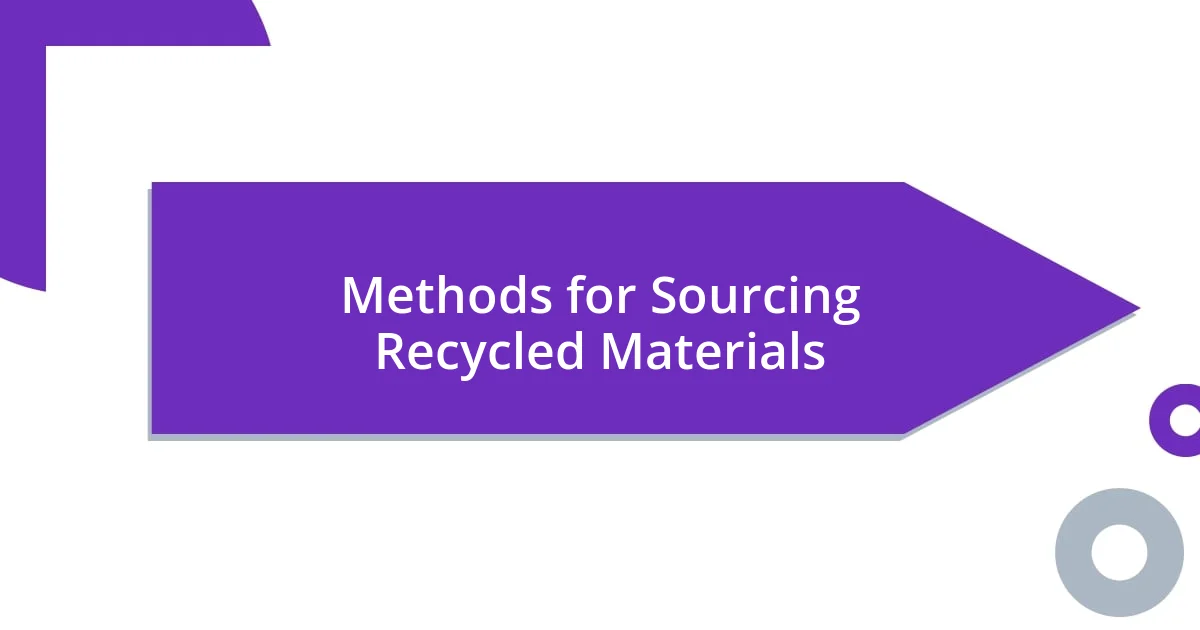Key takeaways:
- Recycled materials not only reduce waste and conserve energy but also add unique character and history to projects.
- Sourcing recycled materials can be done through local community events, online platforms, and local artisans, promoting sustainability and connection.
- Integrating recycled materials into projects fosters creativity and community engagement, showing the potential for discarded items to inspire connections and shared values.

Understanding Recycled Materials Benefits
Recycled materials come with a host of benefits that extend far beyond just environmental impact. For instance, I remember the first time I used reclaimed wood for a DIY project. The unique character of the wood added a warmth to my home that new materials just can’t replicate. Isn’t it thrilling to think that by choosing recycled materials, we can not only reduce waste but also add history and charm to our spaces?
One of the most profound benefits of recycled materials is their role in energy conservation. Did you know that recycling can save up to 95% of the energy required to create new products? I’ve found this particularly enlightening while working on projects, realizing that choosing recycled products isn’t just about aesthetics—it’s about making a tangible difference. Imagining how much energy I’m saving with each reclaimed item inspires me to seek out more sustainable options.
Moreover, the use of recycled materials fosters a sense of community and creativity. Working on community art installations with repurposed materials has opened my eyes to the endless possibilities at our fingertips. Every time I engage in these projects, I ask myself, “What stories do these materials hold?” Using recycled resources has not only been rewarding creatively, but it also connects me with others who share the same passion for sustainability. It’s these experiences that really highlight the broader impact of our choices.

Identifying Suitable Recycled Materials
When it comes to identifying suitable recycled materials, my first step is always to assess what’s readily available in my local area or community. For example, I remember stumbling upon leftover glass bottles from a neighbor’s renovation. Transforming these into colorful planters not only brought life to my garden but also showcased the beauty of upcycled materials. Finding inspiration in your immediate surroundings can lead to truly unique creations.
Another aspect to consider is the condition and usability of recycled materials. During a recent project, I came across some old denim jeans that were beyond wear. Instead of tossing them, I turned them into a lovely recycled fabric rug. This experience taught me that materials might appear unusable at first but, with a bit of creativity, can be transformed into something beautiful and functional. Have you ever considered the potential hidden in your discarded items?
Categorizing materials based on their properties can also help streamline the selection process. I’ve found that grouping materials like plastics, metals, and textiles opens up different possibilities for projects. For instance, while sorting through old magazines, I realized how they can be used for decoupage or mixed media art. It’s fascinating how understanding material characteristics can spark new ideas and enhance creativity in unexpected ways.
| Material | Ideal Use |
|---|---|
| Wood | Furniture, Decor |
| Glass | Planters, Art |
| Plastic | Storage, Crafts |
| Textiles | Rugs, Bags |

Methods for Sourcing Recycled Materials
When I think about sourcing recycled materials, local community resources often come to mind. I’ve had some great luck visiting restoration yards and even checking out community swap events. Imagine walking into a space filled with utterly unique items that people simply don’t need anymore—it’s like an exciting treasure hunt! These local spots not only offer a wide range of materials but also create opportunities for connection with like-minded individuals who value sustainability as much as I do.
- Visit local salvage yards or reuse centers for a variety of materials.
- Attend community swap meets or flea markets to discover unique items.
- Connect with local artisans or craftspeople to exchange materials.
Another effective strategy I’ve adopted is utilizing online platforms. I was surprised at how much I found when I started browsing local Facebook groups and apps like Freecycle. One time, I scored a haul of old wine corks that became the perfect base for a kitchen bulletin board. These online communities foster a spirit of generosity, where people are eager to give away items they no longer need, allowing you to source materials that not only save money but also keep usable resources out of landfills.
- Join online marketplaces like Facebook Marketplace or Craigslist for free or low-cost materials.
- Use platforms like Freecycle or Buy Nothing groups to find items being given away.
- Follow sustainable groups or hashtags on social media for inspiration and material leads.

Innovative Uses of Recycled Materials
I love discovering innovative uses for recycled materials—it’s like finding hidden gems waiting to be transformed. For instance, after a weekend of organizing my garage, I found a stack of old wooden pallets. Rather than letting them decay, I turned them into a rustic coffee table that has become the centerpiece of my living room. Have you ever thought about how something seemingly destined for disposal could bring new life and function into your space?
Diving deeper into creativity, I experimented with transforming plastic bottle caps. I recently created a vibrant mosaic art piece for my kitchen wall by gluing together countless caps that I had been saving. The joy of using those colorful bits not only beautified my space but also made a bold statement about reducing waste. This experience sparked my curiosity—what everyday items could you start collecting for your next creative project?
Another rewarding outcome I’ve had with recycled materials involved reimagining old bicycle tires. After a bike accident left me with a damaged tire, instead of discarding it, I crafted it into a sturdy, unique garden edge. This not only defined my plant beds but sparked conversations with my neighbors about sustainable gardening practices. Can you imagine how creativity can teach us about resourcefulness while also fostering community awareness?

Integrating Recycled Materials into Projects
Integrating recycled materials into projects can be an incredibly fulfilling experience. I remember when I decided to incorporate glass bottles into a privacy fence in my backyard. As I placed each bottle—some vibrant green, others clear—I felt a sense of pride knowing I was not only creating something functional but also artistic. Have you ever considered how materials meant for the recycling bin can become a source of beauty in your home?
One project that truly tested my creativity involved using reclaimed wood from a neighbor’s renovation. I crafted an outdoor bench that’s now a favorite spot for my family gatherings. As I sanded down the rough edges, I thought about the stories these wooden planks must hold. What memories could be made sitting on a piece with such a history? This blend of nostalgia and function supports the idea that recycled materials can maintain a legacy while serving a new purpose.
I’ve also found immense joy in integrating fabric scraps into my home textiles. When I came across a box of old clothes, I couldn’t resist the urge to transform them into a patchwork throw blanket. Each patch carried with it a memory, a connection to the past. It made me wonder—how can we weave our collective histories into tangible creations that warm not just our bodies but our souls as well? Integrating recycled materials invites a dialogue with our environment and history, fostering both creativity and sustainability.

Measuring Impact of Recycled Materials
Measuring the impact of recycled materials in my projects has been an eye-opening journey. For example, after undertaking a home renovation, I calculated the total weight of recycled items I used. It stunned me to discover that I diverted over 500 pounds of waste from landfills! Have you ever paused to consider how small changes can cumulatively have significant environmental effects?
In my experience, it’s essential to not only consider the reduction of waste but also the emotional impact recycled materials can have on our communities. When I built a community garden using surplus wood from a local construction site, it seemed like just a handful of salvaged planks brought people together. Neighbors who had never spoken greeted each other, sharing stories as we worked side by side. This kind of engagement has a ripple effect—how can our creative choices inspire connection and a sense of stewardship in our neighborhoods?
Additionally, I started tracking the lifecycle of each material I used. By documenting where each item came from and its journey to becoming part of my projects, I gained deeper appreciation for sustainability. For instance, the reclaimed glass bottles in my garden boundary didn’t just look beautiful—they represented a cycle of reuse, reducing demand for new materials. How often do we reflect on the stories behind the materials we choose, and how can that awareness shape our purchasing decisions moving forward?

Case Studies of Successful Applications
One standout example I encountered was a local artist utilizing discarded palettes to create striking outdoor sculptures. At first glance, I thought these splintered pieces of wood had no future. Yet, as the artist transformed them into whimsical figures that now grace a community park, I felt a shift in my perception of waste. How often do we overlook the beauty and potential in what we consider trash?
In another instance, a friend’s school project involved turning old tires into colorful planters. Watching the children eagerly paint and decorate these tires ignited a spark of creativity I hadn’t expected. But beyond aesthetics, it made me wonder—what lessons about sustainability are we instilling in our youth? Their joy in repurposing sparked conversations about environmental responsibility that echoed long after our day together.
Lastly, I was inspired by a community initiative that transformed plastic bottle caps into a mosaic mural for a public space. Initially, I thought it was just a fun art project, but as community members shared their personal connections to the caps—each representing a small act of recycling—I realized the deeper emotional currency of their work. How can art redefine our relationship with discarded materials while fostering community ties? This project showcased how collective efforts around recycled materials can become more than just aesthetics; they can represent hopes, histories, and shared values.














